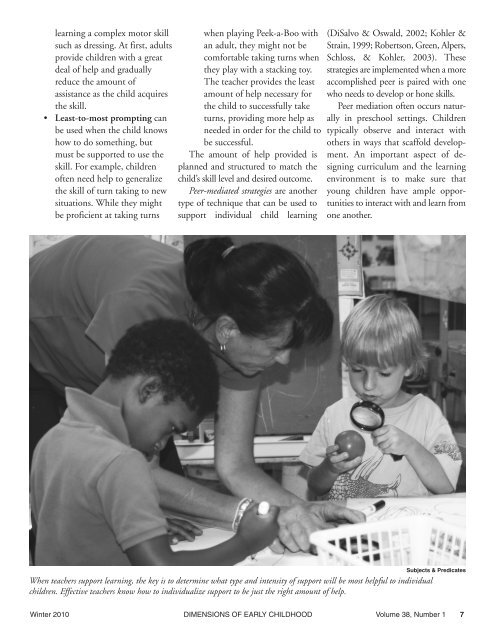90223 Dimensions Winter 10:Layout 1 - Southern Early Childhood ...
90223 Dimensions Winter 10:Layout 1 - Southern Early Childhood ...
90223 Dimensions Winter 10:Layout 1 - Southern Early Childhood ...
Create successful ePaper yourself
Turn your PDF publications into a flip-book with our unique Google optimized e-Paper software.
learning a complex motor skill<br />
such as dressing. At first, adults<br />
provide children with a great<br />
deal of help and gradually<br />
reduce the amount of<br />
assistance as the child acquires<br />
the skill.<br />
• Least-to-most prompting can<br />
be used when the child knows<br />
how to do something, but<br />
must be supported to use the<br />
skill. For example, children<br />
often need help to generalize<br />
the skill of turn taking to new<br />
situations. While they might<br />
be proficient at taking turns<br />
when playing Peek-a-Boo with<br />
an adult, they might not be<br />
comfortable taking turns when<br />
they play with a stacking toy.<br />
The teacher provides the least<br />
amount of help necessary for<br />
the child to successfully take<br />
turns, providing more help as<br />
needed in order for the child to<br />
be successful.<br />
The amount of help provided is<br />
planned and structured to match the<br />
child’s skill level and desired outcome.<br />
Peer-mediated strategies are another<br />
type of technique that can be used to<br />
support individual child learning<br />
(DiSalvo & Oswald, 2002; Kohler &<br />
Strain, 1999; Robertson, Green, Alpers,<br />
Schloss, & Kohler, 2003). These<br />
strategies are implemented when a more<br />
accomplished peer is paired with one<br />
who needs to develop or hone skills.<br />
Peer mediation often occurs naturally<br />
in preschool settings. Children<br />
typically observe and interact with<br />
others in ways that scaffold development.<br />
An important aspect of designing<br />
curriculum and the learning<br />
environment is to make sure that<br />
young children have ample opportunities<br />
to interact with and learn from<br />
one another.<br />
Subjects & Predicates<br />
When teachers support learning, the key is to determine what type and intensity of support will be most helpful to individual<br />
children. Effective teachers know how to individualize support to be just the right amount of help.<br />
<strong>Winter</strong> 20<strong>10</strong> DIMENSIONS OF EARLY CHILDHOOD Volume 38, Number 1 7
















